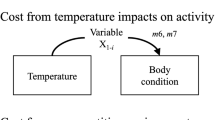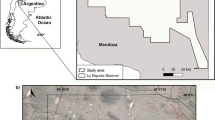Summary
Defense of an area has often been suggested to be more likely when the area contains critical resources which are available more continously, more reliably, or in greater concentration. We report a case in which field experiments and observations of two closely related primate species do not support these expectations. Among other possibilities, the results may indicate conflicting strategies of spacing between males and females.
Similar content being viewed by others
References
Aldrich-Blake, R.P.G., Chivers, D.J.: On the genesis of a group of siamang. Am. J. Phys. Anthropol. 38, 631–636 (1973)
Brown, J.L.: The evolution of diversity in avian territorial systems. Wilson Bull. 76, 160–169 (1964)
Brown, J.L.: The evolution of behavior. New York: Norton 1975
Brown, J.L., Orians, G.H.: Spacing patterns in mobile animals. Annu. Rev. Ecol. Syst. 1, 239–262 (1970)
Carpenter, F.L., Macmillen, R.E.: Threshold model of feeding territoriality and test with a Hawaiian honeycreeper. Science 194, 639–641 (1976)
Chalmers, N.: The visual and vocal communication of free living mangabeys in Uganda. Folia Primatol. 9, 258–280 (1968)
Eisenberg, J.: The evolution of the reproductive unit in the class mammalia. In: Reproductive behavior and evolution. Rosenblatt, J.S., Komisaruk, B.R. (eds.), pp. 39–71. New York: Plenum 1977
Ewald, P.W., Carpenter, F.L.: Territorial responses to energy manipulations in the Anna hummingbird. Oecologia 31, 277–292 (1978)
Gill, F.B., Wolf, LR.: Economics of feeding territoriality in the golden-winged sunbird. Ecology 56, 333–345 (1975)
Homewood, K.: Can the Tana mangabey survive? Oryx 13, 53–59 (1975)
Homewood, K.: Ecology and behaviour of the Tana mangabey. Unpublished Ph.D. thesis, University of London (1976)
Homewook, K.: Feeding strategy of the Tana mangabey (Cercocebus galeritus galeritus). J. Zool. London, 186, 375–391 (1978)
Kodric-Brown, A., Brown, J.H.: Influence of economics, interspecific competition, and sexual dimorphism on territoriality in immigrant rufous hummingbirds. Ecology 59, 285–296 (1978)
Quris, R.: Emissions sonores servant au maintien du groupe social chez Cercocebus galeritus agilis. Terre Vie 27, 232–267 (1973)
Quris, R.: Ecologie et organisation sociale de Cercocebus galeritus agilis dans le nord-est du Gabon. Terre Vie 29, 337–398 (1975)
Schoener, T.W.: Theory of feeding strategies. Annu. Rev. Ecol. Syst. 2, 369–404 (1971)
Smith, C.C.: The adaptive nature of social organization in the genus of tree squirrels Tamiasciuris. Ecol. Monogr. 38, 31–63 (1968)
Tenaza, R.R.: Territory and monogamy among Kloss' gibbons (Hylobates klossii) in Siberut Island, Indonesia. Folia Primatol. 24, 60–80 (1975)
Treisman, M.: The evolutionary restriction of aggression within a species: A game theory analysis. J. Math. Psychol. 16, 167–203 (1977)
Waser, P.M.: Experimental playbacks show vocal mediation of intergroup avoidance in a forest monkey. Nature 255, 56–58 (1975a)
Waser, P.M.: Monthly variations in feeding and activity patterns of the mangabey, Cercocebus albigena (Lydekker). E. Afr. Wildl. J. 13, 249–263 (1975b)
Waser, P.M.: Cercocebus albigena: Site attachment, avoidance, and intergroup spacing. Am. Nat. 110, 911–935 (1976)
Waser, P.M.: Individual recognition, intragroup cohesion, and intergroup spacing: Evidence from sound playback to forest monkeys. Behavior 60, 28–74 (1977a)
Waser, P.M.: Feeding, ranging, and group size in the mangabey Cercocebus albigena. In: Primate ecology. Clutton-Brock, T. (ed.), pp. 183–222. New York: Academic 1977b
Waser, P.M., Wiley, R.H.: Mechanisms and evolution of spacing in animals. In: Social behavior and communication. Marler, P., Vandenburg, J. (eds.). New York: Plenum (in press) 1979
Author information
Authors and Affiliations
Rights and permissions
About this article
Cite this article
Waser, P.M., Homewood, K. Cost-benefit approaches to territoriality: A test with forest primates. Behav Ecol Sociobiol 6, 115–119 (1979). https://doi.org/10.1007/BF00292557
Received:
Accepted:
Issue Date:
DOI: https://doi.org/10.1007/BF00292557




